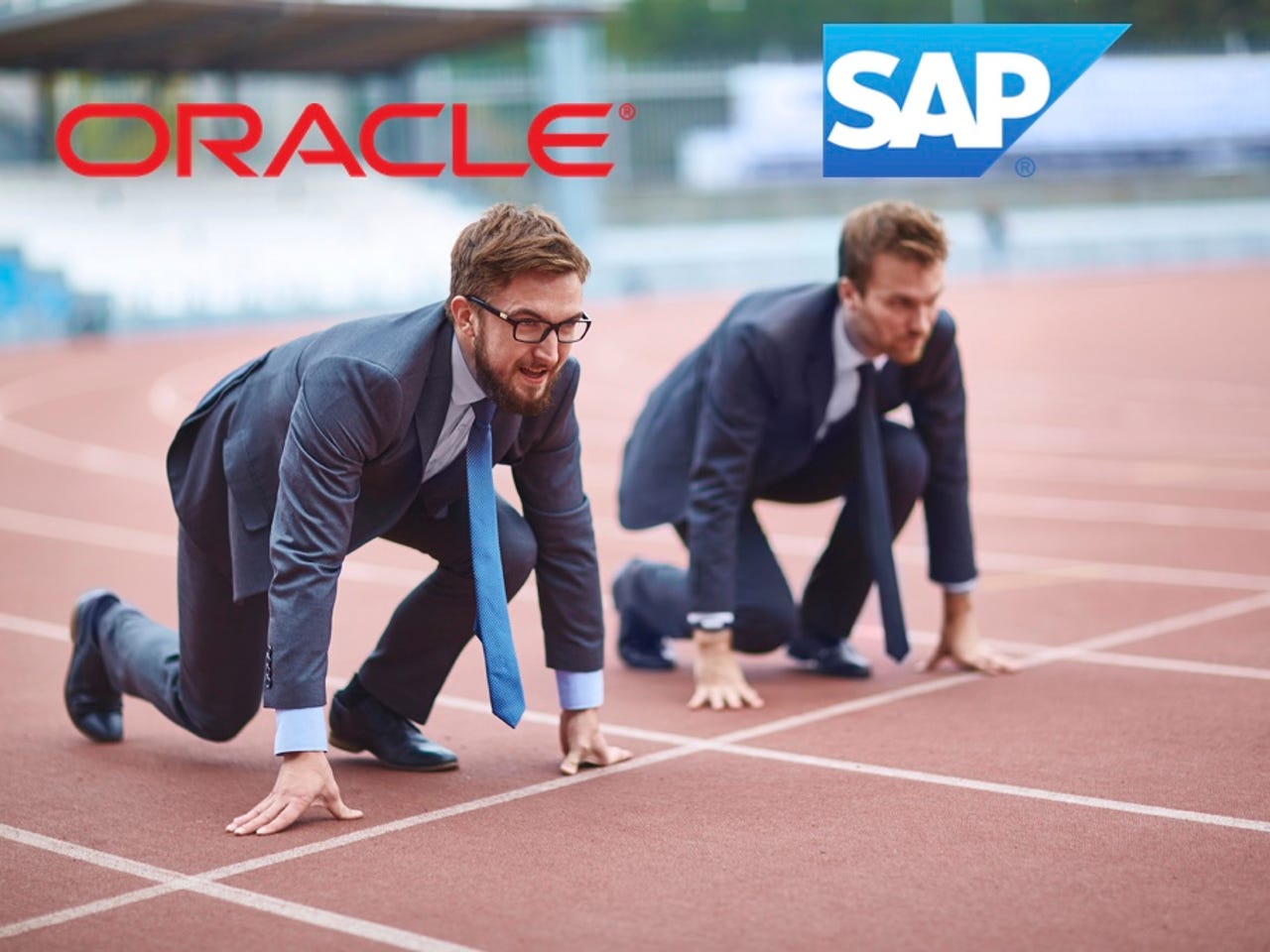What are Oracle and SAP's vision of the future of enterprise apps?


The enterprise technology market is facing a massive shift. The advent and growth of cloud technology, changing customer needs, and the digitization of the workplace means that legacy software companies are changing their approach to maintain their spot at the top.
There's no denying that SAP and Oracle are the two giants in the space, but they are facing some big headwinds in the market. Both are heavily investing in the move from on-premise to the cloud, and working hard to bring their existing customer base with them.
The two companies face many of the same challenges, but their strategies for addressing them are quite different. Let's take a look at their strengths, their opportunities and challenges, as well as their strategy and vision for the future of enterprise apps.
Oracle
Oracle is definitely more of a full infrastructure provider than simply a provider of enterprise apps. However, Forrester's Paul Hamerman said that he would estimate enterprise applications at about 25 percent of its business. The rest being "database, infrastructure, hardware, business intelligence, and a number of other things."
A company that was famously anti-cloud at one point, Oracle has done a complete 180 and is now putting much of its energy towards migrating to the cloud.
"They're very consistent in their messaging -- that's all they really want to talk about," said Christine Dover, research vice-president at IDC.
For both Oracle and SAP, their enterprise app strategy is almost synonymous with their cloud strategy. Both are making acquisitions as well as undergoing organic development, Dover said, but Oracle is slightly ahead in organic development as it has rebuilt many of its back-office applications, as well as its CRM, to be cloud-ready.
Rajan Krishnan, group vice-president of product development for applications at Oracle, said that enterprise customers need horizontal capabilities provided by products like ERP and human capital management (HCM), as well as capabilities that address the needs of the vertical or industry they inhabit.
"For enterprises it's not enough to have just one function, say SFA [sales force automation] or HCM in the cloud," Krishnan said. "They need end-to-end business processes orchestrated by seamless integration across processes and data, underpinned by standards-based technology."
Oracle's cloud foundation lies in its Fusion applications, specifically ERP. Historically HR and CRM have been the early movers to the cloud, with finance lagging -- but that's starting to change, Dover said. And, once applications for systems like accounting shift to the cloud, it will encourage companies to bring other apps into the cloud as well.
"Oracle is focused far more on shifting adoption of formerly on-premise apps to a cloud delivery model -- this includes not just customer experience and human capital management, but also traditionally on-premise ERP and supply chain applications," said Ed Maguire of CLSA.
And, while SAP is focused more on a hybrid approach (which we will discuss later), Oracle is headed more toward the public cloud. The company also supports private cloud, Dover said, but most of their new customers are choosing public cloud.
The big challenge ahead for Oracle is getting its customers on board with the move to the cloud. The economics of the cloud are still very new for many customers and the transition from CAPEX to OPEX can come as a shock. Krishnan said that Oracle's strategy is focused on helping customers move applications to the cloud "selectively" instead of all at once.
A recent Stifel report illustrated the modest nature of Oracle's cloud business by pointing out that "Oracle has converted to SaaS less than fifty million (or less than 1 percent) of its five billion dollar-plus application maintenance business."
However, on an earnings call in October 2015, Oracle CEO Mark Hurd pointed out that the company's SaaS revenue was growing, noting 23 percent growth from 2013 to 2014, and 36 percent growth from 2014 to 2015.
Additionally, Dover said, Oracle has sales promotions where it has essentially given away revenue to get customers into the cloud, and those promotions are ending so we could see a rise in its cloud and applications revenue from that as well.
SAP
SAP's research and development strategy for enterprise apps depends more heavily on acquisitions than Oracle's does. Cloud-native products like Ariba, Concur, and Successfactors were key purchases in filling out SAP's application footprint.
And, those acquisitions were very visible as well, with the company shelling out $8.4 billion for Concur and spending $3.4 billion on Ariba.
"The risk there is to not overpay for growth and to ensure long-term profitability of the acquired businesses," said Max Dufour of Harmeda.
Historically, SAP hasn't operated as deep in the stack as Oracle has, with business applications a bigger part of its offering. And, the core of SAP's application strategy, moving forward, is its in-memory platform HANA -- specifically its business suite S/4 HANA.
"S/4 HANA is built on SAP's in-memory database SAP HANA, which unifies the transactional with the analytical data, lighting up new scenarios, and enabling real-time business," said Quentin Clark, the chief business officer for SAP.
SAP is rebuilding its core with S/4 HANA. Leveraging the analytics capabilities afforded by HANA, Clark said, adding that the company wants to provide contextual and connected agile applications. Fiori, the UX framework utilized by SAP, is supposed to help it build applications with a user-first design that will scale well on mobile.
SAP and Oracle both realize that customers are moving to the cloud piecemeal, as both continue to support on-premise customers and update those offerings. However, the incremental approach is a bigger piece of SAP's strategy.
SAP has begun to rewrite its applications for the cloud, but it's a mixed approach so far. The S/4 HANA applications are available both on-premise and in the cloud, which may mean that SAP is trying to ease its customers towards the cloud more gently. Hamerman said that customers will likely be able to drop in the relevant modules as they need them, instead of jumping into the cloud all at once.
The focus for SAP right now, with its hybrid approach, is customer choice, Dover said.
In terms of revenue, SAP seems to have decent cloud revenues to point to, with more than $2 billion euros in 2015, but that could simply be a result of its strategic acquisitions.
"The thing that SAP has done, where it looks like they've got a lot of cloud revenue, it's because they bought Concur, and they bought Ariba, and they bought Successfactors," Dover said. "That's most of their cloud revenue."
Still, in the recent November 2015 earnings call, SAP CFO and COO Luka Mucic noted that the company has seen growth in its cloud revenue. Additionally, he made a strong prediction for continued growth.
"And we expect also that by 2018 our cloud revenues will finally surpass our software license revenues booked in the same year," Mucic said.
Looking ahead
Oracle and SAP are established leaders in the enterprise, but the game has changed -- including the players involved.
"Where the buyer, historically, has been IT, it now becomes more of a business buyer -- a business executive buyer," Hamerman said.
Both companies will need to elevate their value proposition to speak to this new buyer. Also, Hamerman said, customer focus is critical as the incumbents seek to stand out against their cloud-age competitors. Customers need to feel, ultimately, that they're getting a good value and that they are purchasing access to the tools that they need to stay competitive.
Also see
- SAP's HANA will lose the big data war without open source, as proven by 21 new security flaws (TechRepublic)
- Microsoft, Oracle, AWS are the top database leaders, according to Gartner (TechRepublic)
- Engineering out of Oracle: how SaaS threatens Oracle's database core (ZDNet)
- Engineering out of Oracle: how SaaS threatens Oracle's database core (ZDNet)